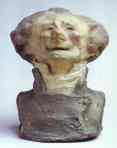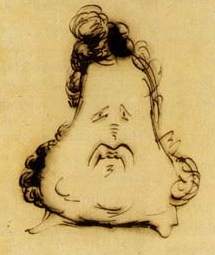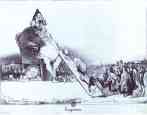Olga's Gallery
Dear Friends of Art,
Today's issue is devoted to the early political caricature in France.
Charles Philipon: the Father of Political Caricature
The first quarter of the 19th century in France was a turbulent time. Napoleon had just been defeated, and the war between the Royalists and Republicans had begun anew with fresh vigor. Charles X, after an attempt to restore the absolutism of the old French monarchy and put an end to the freedom of press, had been forced to abdicate in the July Revolution of 1830. The “citizen-king” Louis-Philippe was elected to take his place. All this political turmoil, plus the new technique of lithography led to the birth of a new popular art form: the political caricature.
 Charles
Philipon was a caricaturist of moderate talent. Although he was responsible
for several caricatures directed against Charles X, published just before
and after the July Revolution, his main contribution to political caricature
was as an entrepreneur. He was the leading partner of Maison Aubert, the
principle Parisian shop-window for caricature of all sorts, and the founder
and editor of the weekly magazine La Caricature and, later, the daily Le
Charivari, both of which were immensely successful. He brought together
the foremost and most talented graphic artists of the time: Daumier,
Grandville, Traviès, Decamps and Jeanron.
Charles
Philipon was a caricaturist of moderate talent. Although he was responsible
for several caricatures directed against Charles X, published just before
and after the July Revolution, his main contribution to political caricature
was as an entrepreneur. He was the leading partner of Maison Aubert, the
principle Parisian shop-window for caricature of all sorts, and the founder
and editor of the weekly magazine La Caricature and, later, the daily Le
Charivari, both of which were immensely successful. He brought together
the foremost and most talented graphic artists of the time: Daumier,
Grandville, Traviès, Decamps and Jeanron.
Philipon was always at the heart of the production: he set the political agenda, which wasn't always shared by the artists, the inspiration for particular caricatures was often his, he was considered the public spokesman for political caricature and was even depicted as the Demon of Caricature incarnate.
At first, Philipon supported the new government of Louis-Philippe, but as the latter began his creeping offensive on the freedom of speech, Philipon turned further to the left. During the year 1831 he was prosecuted 16 times and he spent most of 1832 in prison for his publications against Louis-Philippe. By 1833 he was a committed Republican and used his papers to attract attention for his cause. The caricatures became more and more offensive and aggressive in their attacks on the government and the king, especially after the suppression of Republican uprisings in 1834.
 Philipon's
magazines were the first to portray Louis-Philippe as a pear, a reference
to the shape of the king's head and also a French sexual pun. The symbol
quickly spread and was accepted as the universal symbol for Louis-Philippe
and his regime. It appeared often in caricatures and graffiti. Wax pears
were sold as souvenirs. Finally Philipon went too far and a law was passed
concerning the freedom of press and, in effect, banning political caricature.
Philipon's
magazines were the first to portray Louis-Philippe as a pear, a reference
to the shape of the king's head and also a French sexual pun. The symbol
quickly spread and was accepted as the universal symbol for Louis-Philippe
and his regime. It appeared often in caricatures and graffiti. Wax pears
were sold as souvenirs. Finally Philipon went too far and a law was passed
concerning the freedom of press and, in effect, banning political caricature.
Philipon had foreseen this happening, and shortly prior to the closing of La Caricature, opened the magazine Le Charivari, another satirical newspaper, which attacked, in particular, the Parisian bourgeoisie and the French judicial system.
 In
his magazines, Philipon brought together the best caricaturists of his
time, among them Honoré Daumier. Daumier was born in 1808, in Marseilles,
into the family of a glazier. In 1814 they moved to Paris. Daumier began
to study art in 1822 under Alexandre Lenoir. In about 1828 he started to
work for small publishing houses as a lithographer. In 1830, after the
July Revolution, he met Philipon and began to work for La Caricature. His
work gained popularity after he drew a caricature entitled “Gargantua”
against Louis-Philippe, which earned him a 6-month stay in prison. He had
an amazing ability to capture, and exaggerate, the gestures, mimics and
traits of the model; his series of sculptures of the French deputies is
a testament to that. As a young man, Daumier had worked a little in the
courts of Paris and came to dislike the French judicial system. This contempt
against courts and judges also reflected in his caricatures.
In
his magazines, Philipon brought together the best caricaturists of his
time, among them Honoré Daumier. Daumier was born in 1808, in Marseilles,
into the family of a glazier. In 1814 they moved to Paris. Daumier began
to study art in 1822 under Alexandre Lenoir. In about 1828 he started to
work for small publishing houses as a lithographer. In 1830, after the
July Revolution, he met Philipon and began to work for La Caricature. His
work gained popularity after he drew a caricature entitled “Gargantua”
against Louis-Philippe, which earned him a 6-month stay in prison. He had
an amazing ability to capture, and exaggerate, the gestures, mimics and
traits of the model; his series of sculptures of the French deputies is
a testament to that. As a young man, Daumier had worked a little in the
courts of Paris and came to dislike the French judicial system. This contempt
against courts and judges also reflected in his caricatures.
During the last fortnight we have published the collection of Daumier,
and you can come to admire his caricatures.